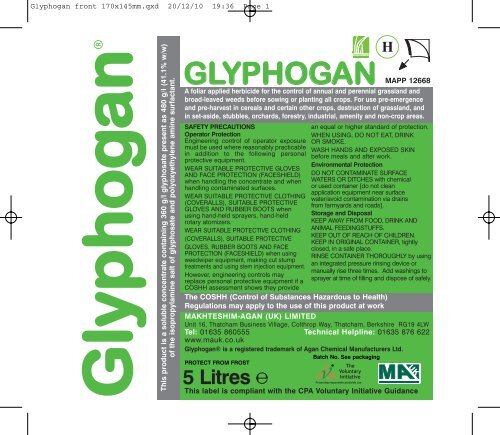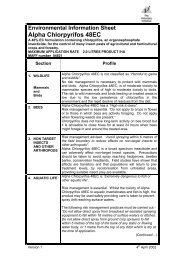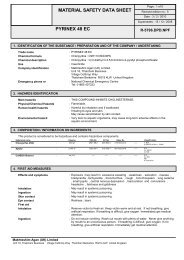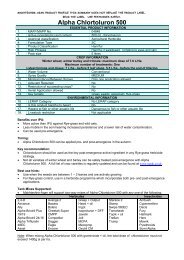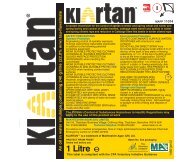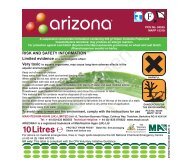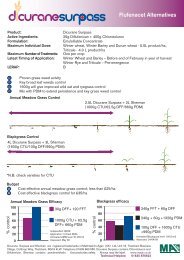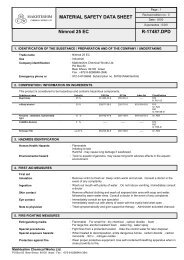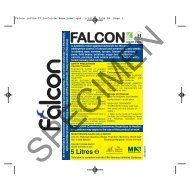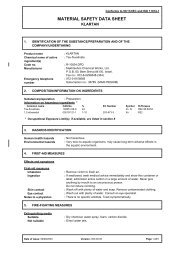GLYPHOGAN - Makhteshim-Agan
GLYPHOGAN - Makhteshim-Agan
GLYPHOGAN - Makhteshim-Agan
- No tags were found...
Create successful ePaper yourself
Turn your PDF publications into a flip-book with our unique Google optimized e-Paper software.
Glyphogan front 170x145mm.qxd 20/12/10 19:36 Page 1<br />
This product is a soluble concentrate containing 360 g/l glyphosate present as 480 g/l (41.1% w/w)<br />
of the isopropylamine salt of glyphosate and polyoxyethylene amine surfactant.<br />
<strong>GLYPHOGAN</strong><br />
HERBICIDE<br />
MAPP<br />
12668<br />
A foliar applied herbicide for the control of annual and perennial grassland and<br />
broad-leaved weeds before sowing or planting all crops. For use pre-emergence<br />
and pre-harvest in cereals and certain other crops, destruction of grassland, and<br />
in set-aside, stubbles, orchards, forestry, industrial, amenity and non-crop areas.<br />
SAFETY PRECAUTIONS<br />
Operator Protection<br />
Engineering control of operator exposure<br />
must be used where reasonably practicable<br />
in addition to the following personal<br />
protective equipment.<br />
WEAR SUITABLE PROTECTIVE GLOVES<br />
AND FACE PROTECTION (FACESHIELD)<br />
when handling the concentrate and when<br />
handling contaminated surfaces.<br />
WEAR SUITABLE PROTECTIVE CLOTHING<br />
(COVERALLS), SUITABLE PROTECTIVE<br />
GLOVES AND RUBBER BOOTS when<br />
using hand-held sprayers, hand-held<br />
rotary atomizers.<br />
WEAR SUITABLE PROTECTIVE CLOTHING<br />
(COVERALLS), SUITABLE PROTECTIVE<br />
GLOVES, RUBBER BOOTS AND FACE<br />
PROTECTION (FACESHIELD) when using<br />
weedwiper equipment, making cut stump<br />
treatments and using stem injection equipment.<br />
However, engineering controls may<br />
replace personal protective equipment if a<br />
COSHH assessment shows they provide<br />
The COSHH (Control of Substances Hazardous to Health)<br />
Regulations may apply to the use of this product at work<br />
MAKHTESHIM-AGAN (UK) LIMITED<br />
Unit 16, Thatcham Business Village, Colthrop Way, Thatcham, Berkshire RG19 4LW<br />
Tel: 01635 860555 Technical Helpline: 01635 876 622<br />
www.mauk.co.uk<br />
Glyphogan® is a registered trademark of <strong>Agan</strong> Chemical Manufacturers Ltd.<br />
Batch No. See packaging<br />
PROTECT FROM FROST<br />
5 Litres<br />
an equal or higher standard of protection.<br />
WHEN USING, DO NOT EAT, DRINK<br />
OR SMOKE.<br />
WASH HANDS AND EXPOSED SKIN<br />
before meals and after work.<br />
Environmental Protection<br />
DO NOT CONTAMINATE SURFACE<br />
WATERS OR DITCHES with chemical<br />
or used container [do not clean<br />
application equipment near surface<br />
water/avoid contamination via drains<br />
from farmyards and roads].<br />
Storage and Disposal<br />
KEEP AWAY FROM FOOD, DRINK AND<br />
ANIMAL FEEDINGSTUFFS.<br />
KEEP OUT OF REACH OF CHILDREN.<br />
KEEP IN ORIGINAL CONTAINER, tightly<br />
closed, in a safe place.<br />
RINSE CONTAINER THOROUGHLY by using<br />
an integrated pressure rinsing device or<br />
manually rise three times. Add washings to<br />
sprayer at time of filling and dispose of safely.<br />
The<br />
Voluntary<br />
Initiative<br />
Promoting responsible pesticide use<br />
This label is compliant with the CPA Voluntary Initiative Guidance<br />
H
Glyphogan 5 litre Booklet 140X145mm.qxd 10/1/11 16:17 Page 1<br />
This leaflet/booklet is part of the approved product label<br />
<strong>GLYPHOGAN</strong> (MAPP 12668)<br />
This product is a soluble concentrate containing 360 g/l glyphosate present as 480 g/l (41.1% w/w) of the isopropylamine salt<br />
of glyphosate and polyoxyethylene amine surfactant.<br />
HARMFUL BY INHALATION.<br />
RISK OF SERIOUS DAMAGE TO<br />
EYES.<br />
TOXIC TO AQUATIC<br />
ORGANISMS, MAY CAUSE<br />
LONG TERM ADVERSE<br />
EFFECTS IN THE AQUATIC<br />
ENVIRONMENT<br />
HARMFUL<br />
DANGEROUS<br />
FOR THE<br />
ENVIRONMENT<br />
IN CASE OF CONTACT WITH EYES, RINSE IMMEDIATELY WITH PLENTY OF WATER AND SEEK<br />
MEDICAL ADVICE.<br />
WEAR EYE/FACE PROTECTION.<br />
THIS MATERIAL AND ITS CONTAINER MUST BE DISPOSED OF IN A SAFE WAY.<br />
USE APPROPRIATE CONTAINMENT TO AVOID ENVIRONMENTAL CONTAMINATION.<br />
To avoid risks to man and the environment, comply with the instructions for use.<br />
IMPORTANT INFORMATION<br />
FOR USE ONLY AS AN AGRICULTURAL/HORTICULTURAL/INDUSTRIAL/FORESTRY HERBICIDE<br />
Crops/situations:<br />
Wheat, barley, oats, combining pea, vining pea, field bean;<br />
Oilseed rape, mustard, linseed;<br />
Sugar beet, swede, turnip, bulb onion, leek, asparagus;<br />
All edible crops (stubble), all non edible crops (stubble);<br />
Grassland;<br />
Apple, pear, plum, cherry, damson;<br />
Green cover on land not being used for crop production;<br />
Amenity vegetation;<br />
Forest nursery, forest (weed control, stump application and chemical thinning).<br />
Natural surfaces not intended to bear vegetation, permeable surfaces overlaying soil, hard surfaces.<br />
All edible and non-edible crops (destruction, before sowing/planting).<br />
Maximum Individual dose: }<br />
Maximum number of treatments: } Full details are given in Statutory Area<br />
Latest timing of application: } on the attached leaflet<br />
Other specific restrictions: } (see Crop Specific Information - marked #)<br />
READ THE LABEL BEFORE USE. USING THIS PRODUCT IN A MANNER THAT IS INCONSISTENT WITH THE LABEL<br />
MAY BE AN OFFENCE. FOLLOW THE CODE OF PRACTICE FOR USING PLANT PROTECTION PRODUCTS.
Glyphogan 5 litre Booklet 140X145mm.qxd 10/1/11 16:17 Page 2<br />
SAFETY PRECAUTIONS<br />
Operator Protection<br />
Engineering control of operator exposure must be used where reasonably practicable in addition to the following<br />
personal protective equipment:<br />
WEAR SUITABLE PROTECTIVE GLOVES AND FACE PROTECTION (FACE-SHIELD) when handling the concentrate<br />
and when handling contaminated surfaces.<br />
WEAR SUITABLE PROTECTIVE CLOTHING (COVERALLS), SUITABLE PROTECTIVE GLOVES AND RUBBER BOOTS<br />
when using hand-held sprayers, hand-held rotary atomizers.<br />
WEAR SUITABLE PROTECTIVE CLOTHING (COVERALLS), SUITABLE PROTECTIVE GLOVES, RUBBER BOOTS AND<br />
FACE PROTECTION (FACESHIELD) when using weedwiper equipment, making cut stump treatments and using stem<br />
injection equipment.<br />
However, engineering controls may replace personal protective equipment if a COSHH assessment shows they provide<br />
an equal or higher standard of protection.<br />
WHEN USING, DO NOT EAT, DRINK OR SMOKE.<br />
WASH HANDS AND EXPOSED SKIN before eating and drinking and after work.<br />
Environmental Protection<br />
DO NOT CONTAMINATE SURFACE WATERS OR DITCHES with chemical or used container [do not clean application<br />
equipment near surface water/avoid contamination via drains from farmyards and roads].<br />
Storage and Disposal<br />
KEEP AWAY FROM FOOD, DRINK AND ANIMAL FEEDINGSTUFFS.<br />
KEEP OUT OF REACH OF CHILDREN.<br />
KEEP IN ORIGINAL CONTAINER, tightly closed, in a safe place.<br />
RINSE CONTAINER THOROUGHLY by using an integrated pressure rinsing device or manually rinse three times.<br />
Add washings to sprayer at time of filling and dispose of safely.<br />
DIRECTIONS FOR USE<br />
IMPORTANT:<br />
This information is approved as part of the Product Label. All instructions within this section must be read carefully in<br />
order to obtain safe and successful use of this product.
Glyphogan 5 litre Booklet 140X145mm.qxd 10/1/11 16:17 Page 3<br />
Warnings<br />
EXTREME CARE SHOULD BE TAKEN TO AVOID SPRAY DRIFT AS THIS CAN SEVERELY DAMAGE NON-TARGET<br />
PLANTS. DO NOT MIX, STORE OR APPLY <strong>GLYPHOGAN</strong> IN GALVANISED OR UNLINED STEEL CONTAINERS OR<br />
SPRAY TANKS.DO NOT leave spray mixtures in tank for long periods and make sure tanks are WELL VENTED.<br />
Restrictions<br />
A period of at least 6 hours and preferably 24 hours rain-free must follow application of Glyphogan.<br />
Do not spray onto weeds which are naturally senescent, or where growth is impaired by drought, high temperatures,<br />
a covering of dust, flooding or frost at, or immediately after application, otherwise poor control may result.<br />
Do not spray in windy conditions as drift onto desired crops or vegetation could severely damage or destroy them.<br />
After application, large concentrations of decaying foliage, stolons, roots or rhizomes should be dispersed or buried<br />
by thorough cultivation before crop drilling.<br />
Applications of lime, fertilizer, farmyard manure and pesticides should be delayed until 5 days after application of<br />
Glyphogan.<br />
Weeds Controlled<br />
Glyphogan is a foliar acting herbicide which controls annual and perennial grasses and most broad-leaved weeds<br />
when used as directed. It is important that all weeds are at the correct stage when treated, otherwise some re-growth<br />
may occur and this will need re-treatment.<br />
Apply Glyohogan herbicide once grasses and broad-leaved weeds have emerged and they have ACTIVELY GROWING<br />
green leaves.<br />
• PERENNIAL GRASSES must have a full emergence of healthy, green leaf. (Common Couch, for example,<br />
becomes susceptible at the onset of tillering and new rhizome growth commences which usually occurs when<br />
plants have 4-5 leaves, each with 10-15 cm of new growth).<br />
• PERENNIAL BROAD-LEAVED WEEDS are most susceptible around the flowering stage.<br />
• ANNUAL GRASSES AND BROAD-LEAVED WEEDS should have at least 5 cm of leaf, or 2 expanded true leaves,<br />
respectively. In set-aside, annual grasses are best treated at full ear emergence, or before stem elongation.<br />
Application during stem extension phase of annual grasses e.g. Black-grass and Brome species on set-aside<br />
between the end of April and end of May, may result in poor control and require re-treatment.
Glyphogan 5 litre Booklet 140X145mm.qxd 10/1/11 16:17 Page 4<br />
• BRACKEN should be treated after frond tips are unfurled, but pre-senescence.<br />
• OTHER SPECIES - recommendations for specific Areas of Use are given in the Recommendation Tables, pages<br />
7 - 14.<br />
• This product will not give an acceptable level of control of Horsetails (Equisetum arvense) - repeat treatment will<br />
be necessary.<br />
Following Crops<br />
Upon soil adsorption the herbicidal properties of Glyphogan are lost permitting the drilling of crops 48 hours after<br />
application.<br />
Planting of trees, shrubs etc may take place 7 days after application. Grass seed may be sown from 5 days after<br />
treatment; see the 'Recommendation Tables' for specific restrictions on direct drilled crops.<br />
Weed resistance strategy<br />
There is low risk for the development of weed resistance to Glyphogan.<br />
Strains of some annual weeds (e.g. Black-grass, Wild oats and Italian Ryegrass) have developed resistance to<br />
herbicides which may lead to poor control. A strategy for preventing and managing such resistance should be adopted.<br />
This should include integrating herbicides with a programme of cultural control measures. Guidelines have been<br />
produced by the Weed Resistance Action Group and copies are available from the HGCA, CPA, your distributor, or crop<br />
adviser.<br />
Growers are encouraged to implement a weed resistance strategy based on (a) Good Agricultural Practices and (b)<br />
Good Plant Protection Practices by:<br />
• Following label recommendations<br />
• The adoption of complimentary weed control practices<br />
• Minimising the risk of spreading weed infestations<br />
• The implementation of good spraying practice to maintain effective weed control<br />
• Using the correct nozzles to maximise coverage<br />
• Application only under appropriate weather conditions<br />
• Monitoring performance and reporting any unexpected results to <strong>Makhteshim</strong>-<strong>Agan</strong><br />
Sprayer Hygiene<br />
It is essential to thoroughly clean-out spray tanks, pumps and pipelines and nozzle or disc assemblies, with a<br />
recommended detergent cleaner, between applying this product and other pesticides to avoid contamination from<br />
pesticide residues. Traces of Glyphogan left in the equipment may seriously damage or destroy crops sprayed later.
Glyphogan 5 litre Booklet 140X145mm.qxd 10/1/11 16:17 Page 5<br />
#CROP SPECIFIC INFORMATION<br />
IMPORTANT INFORMATION<br />
Crops or situations: Maximum individual Maximum total dose Latest time of application:<br />
dose (litres product/ (litres product/<br />
hectare)<br />
hectare)<br />
Pre-harvest of winter wheat, 4.0 4.0 l/ha/crop 7 days before harvest<br />
winter barley, winter oats,<br />
spring wheat, spring barley,<br />
spring oats, durum wheat,<br />
combining peas, field<br />
beans<br />
Pre-harvest of oilseed 4.0 4.0 l/ha/crop 14 days before harvest<br />
rape and linseed<br />
Pre-harvest of mustard 4.0 4.0 l/ha/crop 8 days before harvest<br />
Post planting and pre- 1.5 1.5 l/ha/crop Pre-emergence<br />
emergence of wheat,<br />
barley, oats, oilseed rape,<br />
combining and vining pea,<br />
field bean, mustard,<br />
linseed, sugar beet,<br />
swede, turnip, bulb<br />
onions, leek<br />
Asparagus 5.0 5.0 l/ha/crop Pre-emergence<br />
Stubbles (of all crops) Either: 5.0 5.0 l/ha/year 5 days before drilling or planting of<br />
the following crop<br />
Or: 1.5 1.5 l/ha/year 2 days before the drilling or<br />
planting of the following crop or 24<br />
hours before cultivating<br />
Permanent grassland 6.0 6.0 l/ha/year 5 days before harvest, grazing or<br />
(destruction) Rotational<br />
drilling<br />
grass (destruction)<br />
Natural surfaces not 5.0 - -<br />
intended to bear<br />
vegetation, permeable<br />
surfaces overlaying soil,<br />
hard surfaces
Glyphogan 5 litre Booklet 140X145mm.qxd 10/1/11 16:17 Page 6<br />
Crops or situations: Maximum individual Maximum total dose Latest time of application:<br />
dose (litres product/ (litres product/<br />
hectare)<br />
hectare)<br />
Apple and pear orchards 5.0 5.0 l/ha/year After harvest but before green cluster<br />
stage<br />
Cherry, plum and damson 5.0 5.0 l/ha/year After harvest but before white bud<br />
orchards<br />
stage<br />
Green cover on land 6.0 6.0 l/ha/year 24 hours before cultivating<br />
temporarily removed from<br />
production<br />
Amenity vegetation 5.0 - -<br />
All edible and non-edible 5.0 5.0 l/ha/year Refer to 'Recommendation Tables'<br />
crops (destruction, before<br />
sowing/planting)<br />
Forestry, forest nursery:<br />
Weed control 10.0 - -<br />
Stump application 200 ml/litre of water (20% - -<br />
solution of product in water)<br />
Chemical thinning (by 2 ml per 10 cm diameter - -<br />
injection)<br />
(or less) of tree<br />
Other specific restrictions:<br />
The maximum individual dose must not exceed 22.5 g/l glyphosate for hydraulic knapsack sprayers.<br />
When applying through rotary atomisers the spray droplet spectra produced must be of a minimum Volume Median Diameter (VMD)<br />
of 200 microns.<br />
Weed wipers may be used in any crop where the wiper or chemical does not touch the growing crop.<br />
For weed wiper applications, the maximum concentrations must not exceed the following:<br />
Weed wiper Mini 1:2 dilution with water } Refer to weed wiper guidance under<br />
Other wipers 1:1 dilution with water } 'Mixing & Spraying' section<br />
For stump application, the maximum concentration must not exceed 200 ml of product per litre of water (i.e. a 20% solution).<br />
READ THE LABEL BEFORE USE. USING THIS PRODUCT IN A MANNER THAT IS INCONSISTENT WITH THE LABEL MAY<br />
BE AN OFFENCE. FOLLOW THE CODE OF PRACTICE FOR USING PLANT PROTECTION PRODUCTS.
Glyphogan 5 litre Booklet 140X145mm.qxd 10/1/11 16:17 Page 7<br />
RECOMMENDATION TABLES<br />
AREA OF USE TARGET CROP/SITUATION WEED APPLICATION WATER APPLICATION TIMING AND GUIDANCE<br />
WEEDS/USAGE INFESTATION RATE L/HA VOLUME<br />
PRE-HARVEST Common couch Winter and Spring 1 to 25 shoots/m 2 2.0 (+) 80-250 l/ha* Grain/seed moisture must nor exceed 30% at<br />
ARABLE Wheat, Durum Wheat spraying.<br />
CROPS Winter and Spring Up to 75 shoots/m 2 3.0 Harvest intervals:<br />
Barley and Winter and CEREALS, PEAS, BEANS 7+ days<br />
Spring Oats Over 75 shoots/m 2 4.0 OILSEED RAPE 14-21 days<br />
Oilseed Rape and Up to 75 shoots/m 2 3.0 100-250 l/ha# LINSEED 14-28 days<br />
Mustards Over 75 shoots/m 2 4.0 MUSTARDS 8-10 days<br />
Combining Peas, Field Up to 75 shoots/m 2 3.0 80-250 l/ha* Use high clearance, narrow wheeled tractors, wide<br />
Beans Over 75 shoots/m 2 4.0 booms and crop dividers.<br />
Linseed Up to 75 shoots/m 2 3.0 80-250 l/ha*<br />
Over 75 shoots/m 2 4.0 Where desiccating crops, check susceptibility of<br />
Perennial broad- Winter and Spring All levels of 4.0 80-250 l/ha* any weeds present.<br />
leaved weeds, Wheat, Durum Wheat species<br />
other perennial Winter and Spring Do not attempt to desiccate OILSEED RAPE or<br />
grasses Barley and Winter and MUSTARD crops with significant secondary<br />
Spring Oats<br />
growth, uneven maturity, disease or stress.<br />
Oilseed Rape and All levels of 4.0 100-250 l/ha#<br />
Mustards species Desiccate LINSEED when seeds are light brown and<br />
Combining Peas, Field All levels of 4.0 80-250 l/ha* capsules brown; stems/leaves may be yellow/green.<br />
Beans<br />
species<br />
Linseed All levels of 4.0 80-250 l/ha* Effects on brewing and baking have not been tested.<br />
species<br />
Consult grain merchant or processor before use.<br />
At Harvest managements rates, ANNUAL NETTLE,<br />
VOL. POTATO, ROSEBAY WILLOW HERB and<br />
POLYGONUM WEEDS will not be susceptible.<br />
Wheat crops, WHEAT VOLUNTEERS and BROAD<br />
LEAVED WEEDS may require up to 14 days before<br />
harvest.<br />
Treated straw must not be used as a horticultural<br />
mulch.<br />
DO NOT TREAT CROPS GROWN FOR SEED
Glyphogan 5 litre Booklet 140X145mm.qxd 10/1/11 16:17 Page 8<br />
AREA OF USE TARGET CROP/SITUATION WEED APPLICATION WATER APPLICATION TIMING AND GUIDANCE<br />
WEEDS/USAGE INFESTATION RATE L/HA VOLUME<br />
PRE-HARVEST<br />
ARABLE CROPS<br />
(continued)<br />
Harvest<br />
management<br />
Crop desiccation<br />
and annual weeds<br />
prior to direct<br />
combining<br />
Winter and Spring<br />
Wheat, Durum Wheat,<br />
Winter and Spring<br />
Barley and Winter and<br />
Spring Oats<br />
Oilseed Rape and<br />
Mustards<br />
Linseed<br />
Annual grasses,<br />
crop stems and<br />
leaves<br />
Annual broadleaved<br />
weeds<br />
1.0 (+)<br />
1.5 (+)<br />
All levels/species 3.0<br />
All levels/species 3.0<br />
80-250 l/ha*<br />
100-250<br />
l/ha#<br />
80-250 l/ha<br />
* Rotary atomisers may be used at a water<br />
volume of 40 l/ha. Ensure droplet diameter falls<br />
within the range 200-300 microns.<br />
# Use higher volumes for dense canopies.<br />
(+) For optimum results use Frigate as an<br />
adjuvant at 0.5% spray solution as described in<br />
'Compatibility' section.<br />
STUBBLES PRE-<br />
SOWING AND<br />
PRE-PLANTING<br />
Common Couch<br />
Other perennial<br />
grasses,<br />
volunteer<br />
potatoes (autumn<br />
only)<br />
Volunteer cereals<br />
and annual weeds<br />
Before all crops except<br />
orchards<br />
Up to 75<br />
shoots/m2<br />
Over 75<br />
shoots/m2<br />
All levels of all<br />
species<br />
All levels of all<br />
species<br />
3.0<br />
4.0<br />
4.0<br />
1.5 (+)<br />
80-250 l/ha*<br />
Do not cultivate immediately before spraying.<br />
For PERENNIAL weed control, allow:<br />
- 21+ days growth before spraying in spring<br />
- VOLUTEER POTATOES to make ample top<br />
growth<br />
- 5 days before cultivating or drilling<br />
For ANNUAL weed control, allow:<br />
- 24 hours before cultivating<br />
- 48 hours before drilling<br />
Allow 7 days before planting trees<br />
Perennial broad<br />
leaved weeds<br />
Perennial grasses<br />
and broad-leaved<br />
weeds<br />
Before orchard planting<br />
All levels of all<br />
species<br />
Arable weeds<br />
Pasture weeds<br />
5.0<br />
4.0<br />
5.0<br />
*Rotary atomisers may be used at a water<br />
volume of 40 l/ha. Ensure droplet diameter falls<br />
within the range 200-300 microns.<br />
(+) For optimum results use Frigate as an<br />
adjuvant at 0.5% spray solution as described in<br />
'Compatibility' section.<br />
POST SOWING/<br />
PLANTING, PRE-<br />
EMERGENCE OF<br />
THE CROP<br />
Volunteer cereals<br />
and annual weeds<br />
Listed cereals, oilseed<br />
rape, mustard, linseed,<br />
peas, field beans, sugar<br />
beet, swede, turnip,<br />
bulb onion and leek<br />
All levels/species 1.5<br />
80-250 l/ha*<br />
CAUTION - Ensure that spraying precedes ANY<br />
crop emergence.<br />
Annual weeds<br />
Perennial grasses<br />
Perennial broadleaved<br />
weeds<br />
Asparagus<br />
All levels/species 1.5<br />
4.0<br />
5.0<br />
CAUTION - Ensure that spraying precedes ANY<br />
new spear emergence.
Glyphogan 5 litre Booklet 140X145mm.qxd 10/1/11 16:17 Page 9<br />
AREA OF USE TARGET CROP/SITUATION WEED APPLICATION WATER APPLICATION TIMING AND GUIDANCE<br />
WEEDS/USAGE INFESTATION RATE L/HA VOLUME<br />
ALL EDIBLE AND<br />
NON-EDIBLE<br />
CROPS<br />
(DESTRUCTION,<br />
BEFORE<br />
SOWING/<br />
PLANTING)<br />
Vegetation management<br />
Annual weeds<br />
Perennial<br />
grasses<br />
Perennial broadleaved<br />
weeds<br />
1.5<br />
4.0<br />
5.0<br />
80-250 l/ha*<br />
Or hand held<br />
equipment<br />
(pg xx)<br />
*Rotary atomisers may be used at a water<br />
volume of 40 l/ha. Ensure droplet diameter falls<br />
within the range 200-300 microns<br />
No not use under polythene or glass<br />
Do not use alongside or in hedgerows<br />
Apply at the annual weed dose at least 2 days<br />
before sowing/planting<br />
Apply at the perennial weed dose at least 5 days<br />
before sowing/planting<br />
GREEN COVER Common Couch<br />
ON LAND NOT<br />
BEING USED FOR<br />
CROP<br />
PRODUCTION EG<br />
“SET-ASIDE”<br />
Perennial broadleaved<br />
weeds and<br />
other perennial<br />
grasses<br />
Annual weeds<br />
- Early<br />
autumn/spring<br />
- Late<br />
spring/summer<br />
Natural<br />
regeneration and<br />
cover crop<br />
destruction<br />
Before or during<br />
removal from<br />
production<br />
E.g. prior to growing a<br />
set aside mixture<br />
After short rotation or<br />
long term removal from<br />
production<br />
Up to 75<br />
shoots/m2<br />
Over 75<br />
shoots/m2<br />
All levels/species 4.0<br />
All levels/species 1.5<br />
All levels/species 3.0<br />
Annual weeds<br />
only<br />
Perennial<br />
grasses<br />
Perennial broadleaved<br />
weeds<br />
Perennial broadleaved<br />
weeds as<br />
listed below.<br />
3.0<br />
4.0<br />
3.0<br />
4.0<br />
5.0<br />
6.0+<br />
80-250 l/ha*<br />
or<br />
Hand-held<br />
equipment<br />
(p.X)<br />
Or<br />
Tractor<br />
mounted<br />
weed wiper<br />
(p.XX)<br />
150-250<br />
l/ha*<br />
Before using on land taken out of production as<br />
part of a grant aided scheme, ensure compliance<br />
with the management rules of that scheme. Do<br />
not 'top' or cultivate immediately before<br />
application.<br />
For PERENNIAL weed control, allow:-<br />
- 21+ days growth before spraying in spring<br />
- 5 days before cultivating or drilling<br />
For ANNUAL weed control, allow:<br />
- 24 hours before cultivating<br />
Do not direct drill after set-aside.<br />
Avoid applications during stem elongation as<br />
reduced control and re-spray is likely.<br />
* Rotary atomisers may be used at a water<br />
volume of 40 l/ha. Ensure droplet diameter falls<br />
within the range 200-300 microns.<br />
Best control of annual grasses is achieved<br />
between full ear emergence and senescence.<br />
+ Only for weeds listed as per grassland<br />
destruction application rate table below.
Glyphogan 5 litre Booklet 140X145mm.qxd 10/1/11 16:17 Page 10<br />
AREA OF USE TARGET CROP/SITUATION WEED APPLICATION WATER APPLICATION TIMING AND GUIDANCE<br />
WEEDS/USAGE INFESTATION RATE L/HA VOLUME<br />
PERMANENT<br />
GRASSLAND<br />
(DESTRUCTION)<br />
ROTATIONAL<br />
GRASS<br />
(DESTRUCTION)<br />
Short rotation<br />
Ryegrass, longer<br />
leys and<br />
permanent<br />
pasture<br />
Grass<br />
Short rotation<br />
Ryegrass with<br />
annual weeds<br />
Leys 2-4 years<br />
old with<br />
perennial grass<br />
weeds<br />
Long leys 4-7<br />
years old with<br />
perennial broadleaved<br />
weeds<br />
Permanent<br />
pasture<br />
See weed table<br />
below<br />
3.0<br />
4.0<br />
5.0<br />
6.0<br />
150-250<br />
l/ha*<br />
Treat EITHER before grazing/mowing in June-<br />
Oct, when growth is 30-60 cm, not dense and<br />
lacking mature seeds, OR re-growth after<br />
grazing/mowing.<br />
Select the application rate which<br />
controls/destroys the least susceptible weed and<br />
grass species present in the sward.<br />
Grass may be conserved or grazed by cattle,<br />
dairy cows or sheep 5+ days after spraying.<br />
REMOVE POISONOUS PLANTS BEFORE<br />
GRAZING/MOWING.<br />
ONLY direct drill grass and clover EITHER into 1-<br />
2 year leys without mat, 5+ days after spraying,<br />
OR long leys with some mat, in the spring<br />
following autumn application.<br />
* Rotary atomisers may be used at a water<br />
volume of 40 l/ha. Ensure droplet diameter falls<br />
within the range 200-300 microns.<br />
APPLICATION RATES FOR GRASSLAND DESTRUCTION<br />
3.0 l/ha 4.0 l/ha<br />
Annual Meadow-grass Meadow Fescue Black Bent Creeping Soft-grass<br />
Common Chickweed Meadow Foxtail Broad-leaved Dock Curled Dock<br />
Common Mouse-ear Rough Meadow-grass Cock's Foot Perennial Rye-grass<br />
Dock seedlings Speedwell species Common Bent Plantains<br />
Italian Rye-grass Timothy Common Couch Soft Brome<br />
Mayweed species Creeping Bent Yorkshire Fog<br />
APPLICATION RATES FOR GRASSLAND DESTRUCTION<br />
5.0 l/ha 6.0 l/ha<br />
Bracken** Red Clover Common Ragwort Nardus (Mat grass)<br />
Common Sorrel Sedges Hard Rush Red Fescue<br />
Common Nettle Sheep's Sorrel Heath Rush White Clover*<br />
Creeping Buttercup* Soft Rush Jointed Rush Yellow Rattle<br />
Creeping Thistle Spear Thistle Molinia (Purple Moor-grass) Sheep's Fescue<br />
Daisy<br />
Tufted Hair-grass<br />
Dwarf ThistleYarrow Yarrow<br />
Perennial Sow-thistle<br />
* White Clover is best cut in June and sprayed one month later.<br />
** At full frond expansion.
Glyphogan 5 litre Booklet 140X145mm.qxd 10/1/11 16:17 Page 11<br />
AREA OF USE TARGET CROP/SITUATION WEED APPLICATION WATER APPLICATION TIMING AND GUIDANCE<br />
WEEDS/USAGE INFESTATION RATE L/HA VOLUME<br />
AMENITY<br />
VEGETATION<br />
Vegetation<br />
management<br />
Areas of semi-natural or<br />
ornamental vegetation<br />
including trees. Areas<br />
of bare soil around<br />
ornamental plants or<br />
areas intended for<br />
ornamental planting.<br />
Annual weeds<br />
Perennial<br />
grasses and<br />
broad-leaved<br />
weeds<br />
1.5<br />
4.0-5.0<br />
80-400 l/ha<br />
Hydraulic sprayers, rotary atomisers or weed<br />
wipers may be used.<br />
DO NOT USE IN OR ALONGSIDE HEDGEROWS.<br />
* Rotary atomisers may be used at a water<br />
volume of 40 l/ha. Ensure droplet diameter falls<br />
within the range 200-300 microns.<br />
DO NOT USE UNDER POLYTHENE OR GLASS<br />
ORCHARDS<br />
Perennial grasses<br />
and broad-leaved<br />
weeds<br />
Within orchards of<br />
Apple, Pear, Plum,<br />
Cherry or Damson<br />
All level of most<br />
species<br />
5.0<br />
200-400 l/ha<br />
Trees must have been established for 2 years<br />
before spraying.<br />
Spray AFTER autumn leaf-fall and BEFORE;<br />
Root suckers<br />
-<br />
All species<br />
5.0<br />
Apples, pears - green cluster stage<br />
Stone fruit - white bud stage<br />
Avoid contact with tree branches and trunks<br />
above 30 cm from the ground.<br />
Treat suckers in late spring only.<br />
NATURAL Annual weeds<br />
SURFACES NOT<br />
INTENDED TO Perennial grasses<br />
BEAR<br />
VEGETATION, Perennial<br />
PERMEABLE broadleaved<br />
SURFACES Weeds<br />
OVERLYING SOIL,<br />
HARD SURFACES<br />
-<br />
All levels/species 1.5<br />
All levels/species 4.0<br />
All levels/species 5.0<br />
Hydraulic<br />
sprayers:<br />
80-250 l/ha<br />
or<br />
Rotary<br />
atomisers<br />
40 l/ha*<br />
* Rotary atomisers may be used at a water<br />
volume of 40 l/ha. Ensure droplet diameter falls<br />
within the range 200-300 microns.<br />
Use areas include:<br />
Roadsides, paths, hard surfaces, along fences<br />
and walls and total weed control on industrial<br />
sites.<br />
DO NOT USE IN OR ALONGSIDE HEDGEROWS.<br />
DO NOT USE UNDER GLASS OR<br />
POLYETHYLENE.
Glyphogan 5 litre Booklet 140X145mm.qxd 10/1/11 16:17 Page 12<br />
Forestry Weed Control<br />
Glyphogan can be used for site preparation and for weed control in planted out trees.<br />
AREA OF USE TARGET WEEDS/ WEED APPLICATION WATER VOLUME APPLICATION GUIDANCE<br />
USAGE INFESTATION RATE L/HA<br />
Forestry:<br />
- Pre-planting<br />
Arable land,<br />
planting,<br />
replanting, &<br />
grassland areas<br />
Arable weeds<br />
Grassland weeds<br />
4.0<br />
5.0<br />
80-250 l/ha*<br />
All tree species may be<br />
planted 7 days or more after<br />
treatment.<br />
* Rotary atomisers may be<br />
used at a water volume of 40<br />
l/ha. Ensure droplet diameter<br />
falls within the range 200-300<br />
microns.<br />
Forestry:<br />
- Post-planting<br />
(directed) in conifers<br />
& broad-leaved trees<br />
Clean up around<br />
trees with<br />
knapsack<br />
applications.<br />
Annual/perennial<br />
grasses and broadleaves<br />
Woody weeds:<br />
Bracken/Beech<br />
Brush/Brambles<br />
Sycamore/Oak<br />
Hazel/Willow/Ash<br />
Heather (peat soils)<br />
Heather (mineral<br />
soils)<br />
4.0<br />
3.0<br />
4.0<br />
6.0<br />
Knapsack<br />
sprayers:<br />
200-250 l/ha<br />
Or<br />
Weed wiper mini:<br />
1 part Glyphogan<br />
to 2 parts water<br />
See Mixing and<br />
Spraying section.<br />
It is ESSENTIAL to use a<br />
TREE GUARD for all<br />
applications made in the<br />
growing season.<br />
Treat bracken after frond tips<br />
are unfurled but before<br />
senescence.<br />
Treat heather late August to<br />
end September.<br />
All other woody weeds are<br />
treated June-August, before<br />
leaf senescence (but after<br />
new growth of crop has<br />
hardened).<br />
Rhododendron (*)<br />
10.0<br />
250 l/ha<br />
Cut back and treat re-growth<br />
when at least 1 metre in<br />
height throughout the entire<br />
coppice. Spray to just before<br />
point of run-off.<br />
(*) For improved control of<br />
Rhododendron add Mixture B<br />
(ADJ A0161) at a<br />
concentration of 2% final<br />
water volume to 8.0 l/ha of<br />
Glyphogan. Application<br />
using the weed wiper is not<br />
suitable.
Glyphogan 5 litre Booklet 140X145mm.qxd 10/1/11 16:17 Page 13<br />
AREA OF USE TARGET WEEDS/ WEED APPLICATION WATER VOLUME APPLICATION GUIDANCE<br />
USAGE INFESTATION RATE L/HA<br />
Forestry:<br />
- Post-planting<br />
(overall application<br />
in dormant season<br />
in certain conifers -<br />
conifer release)<br />
Grass weeds<br />
- Lowland areas<br />
- Upland areas<br />
Bracken<br />
Beech & Birch<br />
Brambles<br />
1.5<br />
2.0<br />
Black Bent, Cock'sfoot,<br />
Common<br />
Couch, Creeping<br />
Soft-grass, False<br />
Oat-grass,<br />
Fescues, Meadowgrasses,<br />
Other<br />
Bent species,<br />
Purple Moor-grass,<br />
Sweet Vernalgrass,<br />
Tufted Hairgrass,<br />
Wavy<br />
Hair-grass, Wood<br />
Small-reed (Bush<br />
grass)<br />
All levels of species<br />
All levels of species<br />
All levels of species<br />
2.0<br />
2.0<br />
3.0<br />
Hydraulic<br />
sprayers: 200-<br />
250 l/ha<br />
Or<br />
Hand-held<br />
equipment - see<br />
'Mixing and<br />
Spraying' section<br />
DO NOT OVERALL SPRAY<br />
trees being grown for<br />
ORNAMENTAL PURPOSES,<br />
including CHRISTMAS<br />
TREES.<br />
Species safe to spray when<br />
fully dormant and leader<br />
growth has hardened:<br />
Corsican, Lodgepole and<br />
Scots Pines, Norway Spruce,<br />
Sitka Spruce, Lawson<br />
Cypress, Western Red Cedar.<br />
Species safe to spray when<br />
fully dormant and leader<br />
growth has hardened but<br />
NOT in spring: Douglas Fir<br />
and Noble Fir.<br />
If overall application takes<br />
place after the optimum<br />
timing weed control may be<br />
reduced. It is advisable to<br />
spray a limited area of forest<br />
to test crop safety under local<br />
conditions before widespread<br />
overall application in<br />
subsequent years.<br />
These recommended<br />
application rates refer to<br />
forestry usage only.<br />
Inadequate control may result<br />
if used in other areas:<br />
Caution: The timing of<br />
hardening of leader growth<br />
varies considerably between<br />
locations and between<br />
seasons. It may occur as<br />
early as the end of July or be<br />
delayed to October or later.<br />
To avoid damage to Lammas<br />
growth, sprays should be<br />
directed away from leaders.
Glyphogan 5 litre Booklet 140X145mm.qxd 10/1/11 16:17 Page 14<br />
AREA OF USE TARGET WEEDS/ WEED APPLICATION WATER VOLUME APPLICATION GUIDANCE<br />
USAGE INFESTATION RATE L/HA<br />
Forestry:<br />
- Stump application<br />
for chemical thinning<br />
Deciduous trees<br />
Coniferous trees<br />
All species<br />
All species<br />
10% solution of Glyphogan in water<br />
20% solution of Glyphogan in water<br />
Apply the solution to saturate<br />
the rim of the newly cut<br />
surface, with a suitable<br />
adapted clearing saw, spot<br />
gun or paintbrush. Treat as<br />
soon as possible (within a<br />
week) after felling, in the<br />
period November to March.<br />
Do not apply in the period of<br />
active sap flow in the<br />
spring/early summer. Do not<br />
cut trenches or drill holes and<br />
fill with the solution or use<br />
undiluted product.<br />
Note: for ease of<br />
identification of treated areas<br />
a suitable, commercially<br />
available, water-soluble dye<br />
may be added to the<br />
prepared spray solution.<br />
Forestry:<br />
- Chemical thinning<br />
by injection of tree<br />
stems<br />
Coniferous and<br />
deciduous species<br />
-<br />
2 ml neat Glyphogan per cut per 10<br />
cm diameter (or less) tree<br />
Use a hatchet to cut one<br />
notch in trees up to 10 cm<br />
diameter and apply 2 ml of<br />
the solution to each cut. Use<br />
two or three notches in trees<br />
over 10 cm diameter. Do not<br />
treat in the period of active<br />
sap flow in the spring/early<br />
summer.<br />
Mixing and Spraying<br />
Glyphogan mixes readily with water and can be applied in spray volumes ranging from 80-400 l/ha using tractor<br />
mounted, knapsack, rotary atomisers and hand-held sprayers. Specialised application equipment such as weed<br />
wipers, stem injection and spot gun applicators may be used where indicated.<br />
Correctly calibrate all sprayers under field or use conditions prior to application.<br />
a) Tractor mounted and powered sprayers<br />
These should be capable of applying accurately 80-400 l/ha within a pressure range of 1.5-2.5 bars (20-35 psi).<br />
Half fill the spray tank with clean water, start gentle agitation, and then add the correct amount of Glyphogan. Top<br />
up the tank with water to the required level. To avoid foaming do not use top tank agitation. Use of a defoamer<br />
may be necessary.
Glyphogan 5 litre Booklet 140X145mm.qxd 10/1/11 16:17 Page 15<br />
All applications using hydraulic sprayers (including knapsack sprayers) to be as 'MEDIUM' or “COARSE' spray quality<br />
(BCPC definition).<br />
Medium Volume application (150-300 l/ha)<br />
Avoid high water volumes (>300 l/ha) which may lead to run-off from the treated vegetation, resulting in reduced<br />
control. Low drift nozzles such as air induction and pre-orifice types producing a medium or coarse spray (BCPC<br />
definition) should be used to minimise the risk of drift.<br />
Low Volume Application (minimum 80 l/ha)<br />
Low volume application can be achieved by reducing pressure and the appropriate nozzle selection. Low drift nozzles<br />
which produce a medium spray quality (BCPC definition) should be used to minimise the risk of drift.<br />
b) Knapsack sprayers<br />
Recommended delivery range is 80-300 l/ha. Half fill the spray tank with clean water, add the correct amount to<br />
Glyphogan and top up with water. Fill according to best practice as given on the CPA's Voluntary Initiative website<br />
(www. Voluntaryinitiative.org.uk)<br />
When used at a walking speed of 1 m/sec to apply a swath of 1 m width, most knapsack sprayers fitted with a<br />
Lurmark AN 2.0 or similar nozzle deliver approximately 200 l/ha spray volume (or 10 L per 500 m2). To apply 4.0<br />
l/ha of <strong>GLYPHOGAN</strong>, therefore, use 40 ml of product for each 2 litres of spray liquid required. Similarly, knapsack<br />
sprayers fitted with low volume nozzles such as Lurmark AN 1.0 typically deliver approximately 100 l/ha spray<br />
volume. To apply 4.0 l/ha <strong>GLYPHOGAN</strong> in this case, use 80 ml of product for each 2 litres of spray liquid required.<br />
c) Rotary Atomisers<br />
Tractor-mounted boom sprayers and hand-held machines are suitable for use in some situations to apply a<br />
minimum spray volume of 40 l/ha.<br />
When rotary atomisers are used to apply Glyphogan ensure that the droplet diameter falls within the range 200<br />
300 microns for all uses.<br />
Stir the correct amount of Glyphogan to control the particular target species into the sprayer bottle half filled with<br />
clean water. Top up with water, close the top and shake gently to ensure good mixing.<br />
Do not tank mix Glyphogan when using rotary atomiser sprayers.
Glyphogan 5 litre Booklet 140X145mm.qxd 10/1/11 16:17 Page 16<br />
d) Weed Wipers<br />
For ropewick applicators use a concentration of 1 part Glyphogan to 2 parts of water and add a water-soluble dye<br />
if required. Care should be taken to avoid dripping onto wanted vegetation.<br />
For new generation weed wipers, use 1 part Glyphogan to 10 to 20 parts of water or as directed by manufacturer's<br />
instructions.<br />
e) Cut Stump Applicators<br />
For cut stump treatment an Enso attachment to rotary saws may be used.<br />
This technique is specific to scrub clearance in forestry. A suitable water soluble dye may be used.<br />
f) Stem Injection<br />
Use a hatchet to cut one notch in trees up to 10 cm diameter and two to three notches in trees above 10 cm<br />
diameter. Use 2.0 ml of undiluted Glyphogan per notch.<br />
g) Spot Gun Applicators<br />
Spot gun applicators are for the treatment of individual weeds. Apply 5 ml of spray to target weed, using a narrow<br />
cone TG-3 or TG-5 nozzle<br />
Spot Diameter (metres) Amount of Glyphogan (ml) per 5 litres spray solution for targeted dosages of:<br />
3.0 l/ha 4.0 l/ha 5.0 l/ha<br />
0.3 20 28 35<br />
0.6 85 110 140<br />
Compatibility<br />
Consult <strong>Makhteshim</strong> <strong>Agan</strong> (UK) Ltd before tank mixing with any adjuvants or pesticides.
Glyphogan 5 litre Booklet 140X145mm.qxd 10/1/11 16:17 Page 17<br />
COMPANY ADVISORY INFORMATION<br />
This section is not part of the Product Label under the Plant Protection Products Regulations 1995 and provides<br />
additional advice on the product.<br />
General Information<br />
Glyphogan is taken up by foliage and translocated to underground roots, rhizomes and stolons, providing control of<br />
both annual and perennial grasses and broad-leaved weeds. Glyphogan is rapidly adsorbed onto particulate matter<br />
in soils and water and is quickly degraded by the micro-organism present in soil and aquatic bottom sediments. Until<br />
degraded, the active ingredient in Glyphogan, glyphosate, is practically immobile in soils and is, therefore, unlikely to<br />
contaminate groundwater.<br />
To maximise the safety of Glyphogan to the operator, consumer and environment, the label recommendations and the<br />
DEFRA/HSC/NAW publication "Code of Practice for Using Plant Protection Products” of January 2006, should be<br />
adhered to.<br />
Symptoms on the Weeds<br />
Symptoms of treatment are generally first seen 7-10 days, or longer (if growth is slow), after spraying. These take the<br />
form of leaf reddening followed by yellowing and are usually quicker to appear on grasses than on broad-leaved<br />
weeds. Reaction of nettles is slow.<br />
Effects of Weather<br />
See Directions for Use (Restrictions).<br />
Glyphogan will remain efficacious at low but not freezing temperatures however the onset of symptoms will be delayed.<br />
A covering of dew may reduce efficacy where run-off occurs. Reduced control is likely where weed growth is impaired<br />
by natural senescence, drought, high temperature, a covering of dust, flooding or sever/prolonged frost at, or<br />
immediately after, application.<br />
Agronomic Advice<br />
Applications of lime, fertiliser, farmyard manure and pesticides should be delayed until 5 days AFTER application of<br />
Glyphogan.
Glyphogan 5 litre Booklet 140X145mm.qxd 10/1/11 16:17 Page 18<br />
General Cautions<br />
Take extreme care to avoid drift, particularly when using near or alongside hedgerows. The use of low drift nozzles<br />
such as 'air induction' and 'pre-orifice' nozzles are recommended.<br />
After application, large concentrations of decaying foliage, stolons, roots or rhizomes should be dispersed or buried<br />
by thorough cultivation before crop drilling.<br />
New Generation Weed Wipers<br />
Logic Contact 2000<br />
Carier Rollmaster<br />
Allman Ecowipe<br />
Rotowiper (UK) Ltd<br />
C-Dax Eliminator<br />
Weedswiper<br />
Disposal<br />
Follow the guidance on the disposal of surplus spray solution, tank washings, concentrate and containers as given in<br />
the DEFRA/HSC/NAW publication "Code of Practice for Using Plant Protection Products” of January 2006.<br />
CONDITIONS OF SUPPLY<br />
All goods supplied by us are of high grade and we believe them to be suitable, but as we cannot exercise control over<br />
their storage, handling, mixing or use, or the weather conditions before, during and after application which may affect<br />
the performance of the goods, all conditions and warranties, statutory or otherwise, as to the quality of fitness for any<br />
purpose of our goods are excluded, and no responsibility will be accepted by us or re-sellers for any failure in<br />
performance, damage or injury whatsoever arising from their storage, handling application or use. These conditions<br />
cannot be varied by our staff or agents whether or not they supervise or assist in the use of such goods.<br />
<strong>Makhteshim</strong>-<strong>Agan</strong> (UK) Limited<br />
Unit 16, Thatcham Business Village, Colthrop Way, Thatcham, Berks RG19 4LW ENGLAND<br />
Tel: 01635 860555 Technical helpline: 01635 876622 www.mauk.co.uk Email: admin@mauk.co.uk<br />
In case of emergency day or night, telephone National Chemical Emergency Centre: (01865) 407333.<br />
© Copyright of <strong>Makhteshim</strong>-<strong>Agan</strong> (UK) Ltd.
Glyphogan 5 litre Booklet 140X145mm.qxd 10/1/11 16:17 Page 19<br />
MATERIAL SAFETY DATA SHEET<br />
<strong>GLYPHOGAN</strong> MAPP 12668<br />
This Safety Data Sheet does not form part of the label approved<br />
under the Plant Protection Product Regulation 1995<br />
1. PRODUCT AND COMPANY IDENTIFICATION<br />
Product name<br />
: <strong>GLYPHOGAN</strong><br />
Product use<br />
: Herbicide<br />
Chemical name<br />
: Not applicable<br />
Synonyms<br />
: None<br />
Company/(Sales office) : CardelAgro S.P.R.L./B.V.B.A. Avenue de Tervuren - Tervurenlaan 270-272,<br />
1150 Brussels, Belgium<br />
Company identification : <strong>Makhteshim</strong> Chemical Works Ltd. PO Box 60 , Beer Sheva 84100 Israel.<br />
Fax : +972-8-6296848 MSDS@ma-industries.com<br />
Telephone: : +32 (0)2 776 76 52<br />
Fax: : +32 (0)2 776 48 13<br />
Emergency numbers : Telephone: Belgium +32 (0)3 568 51 23<br />
2. COMPOSITION/INFORMATION ON INGREDIENTS<br />
Active ingredient : Isopropylamine salt of N-(phosphonomethyl)glycine;<br />
{Isopropylamine salt of glyphosate}<br />
Composition<br />
Components CAS No. Einecs/ % by weight EU Symbols & R<br />
Elincs No. (approximate) phrases of components<br />
Isopropylamine salt of 38641-94-0 254-056-8 41.5 N; R51/53; {b}<br />
glyphosate<br />
Surfactant 61791-26-2 15.5 Xn, N; R22, 41, 51/53; {a}<br />
Water 7732-18-5 231-791-2 43<br />
3. HAZARDS IDENTIFICATION<br />
EU label (manufacturer : Classification following the EU Dangerous Preparations' Directive 1999/45/EC.<br />
self-classification) Xi - Irritant, N - Dangerous for the environment<br />
R36 : Irritating to eyes.<br />
R51/53 : Toxic to aquatic organisms, may cause long-term adverse effects in<br />
the aquatic environment.<br />
National classification : U.K.<br />
Xi - Irritant, N - Dangerous for the environment<br />
R36 : Irritating to eyes.<br />
R51/53 : Toxic to aquatic organisms, may cause long-term adverse effects in<br />
the aquatic environment.
Glyphogan 5 litre Booklet 140X145mm.qxd 10/1/11 16:17 Page 20<br />
Potential health effects<br />
Likely routes of exposure<br />
Eye contact, short term<br />
Skin contact, short term<br />
Inhalation, short term<br />
: Skin contact, eye contact.<br />
: May cause temporary eye irritation.<br />
: Not expected to produce significant adverse effects when recommended use<br />
instructions are followed.<br />
: Not expected to produce significant adverse effects when recommended use<br />
instructions are followed.<br />
Potential environmental effects<br />
Toxic to aquatic organisms.<br />
May cause long-term adverse effects in the aquatic environment.<br />
Refer to section 11 for toxicological and section 12 for environmental information.<br />
4. FIRST-AID MEASURES<br />
Eye contact<br />
Skin contact<br />
Inhalation<br />
Ingestion<br />
Advice to doctors<br />
Antidote<br />
: Immediately flush with plenty of water. Continue for at least 15 minutes.<br />
If easy to do, remove contact lenses. If there are persistent symptoms, obtain<br />
medical advice.<br />
: Take off contaminated clothing, wristwatch, jewellery. Wash affected skin with<br />
plenty of water. Wash clothes and clean shoes before re-use.<br />
: Remove to fresh air.<br />
: Immediately offer water to drink. Never give anything by mouth to an unconscious<br />
person. Do NOT induce vomiting unless directed by medical personnel.<br />
If symptoms occur, get medical attention.<br />
: This product is not an inhibitor of cholinesterase.<br />
: Treatment with atropine and oximes is not indicated.<br />
5. FIRE-FIGHTING MEASURES<br />
Flash point<br />
: Does not flash.<br />
Extinguishing media : Recommended: Water, foam, dry chemical, carbon dioxide (CO2)<br />
Unusual fire and explosion : Minimise use of water to prevent environmental contamination.<br />
hazards Environmental precautions: see section 6.<br />
Hazardous products of : Carbon monoxide (CO), phosphorus oxides (PxOy), nitrogen oxides (NOx)<br />
combustion<br />
Fire fighting equipment : Self-contained breathing apparatus.<br />
Equipment should be thoroughly decontaminated after use.
Glyphogan 5 litre Booklet 140X145mm.qxd 10/1/11 16:17 Page 21<br />
6. ACCIDENTAL RELEASE MEASURES<br />
Personal precautions : Keep all non-essential people away from affected area.<br />
Use personal protection recommended in section 8.<br />
Warn everybody of irritant/corrosive hazard.<br />
Environmental precautions : Minimise spread. Keep out of drains, sewers, ditches and water ways.<br />
Notify authorities.<br />
Methods for cleaning up : Absorb in earth, sand or absorbent material. Dig up heavily contaminated soil.<br />
Collect in containers for disposal. Refer to section 7 for types of containers.<br />
Minimise use of water to prevent environmental contamination.<br />
Do NOT flush away with water.<br />
Refer to section 13 for disposal of spilled material.<br />
7. HANDLING AND STORAGE<br />
Good industrial practice in housekeeping and personal hygiene should be followed.<br />
Handling<br />
: Avoid contact with eyes. When using do not eat, drink or smoke.<br />
Wash hands thoroughly after handling or contact.<br />
Thoroughly clean equipment after use.<br />
Do not contaminate drains, sewers and water ways when disposing of equipment<br />
rinse water. Emptied containers retain vapour and product residue.<br />
FOLLOW LABELLED WARNINGS EVEN AFTER CONTAINER IS EMPTIED.<br />
Storage : Minimum storage temperature: -15 °C. Maximum storage temperature: 50 °C<br />
Compatible materials for storage: stainless steel, aluminium, fibreglass, plastic, glass<br />
lining. Incompatible materials for storage: galvanised steel, unlined mild steel, see<br />
section 10. Keep out of reach of children. Keep away from food, drink and animal<br />
feed. Keep only in the original container. Partial crystallization may occur on<br />
prolonged storage below the minimum storage temperature. If frozen, place in warm<br />
room and shake frequently to put back into solution. Minimum shelf life: 5 years.<br />
Use appropriate containment to avoid environmental contamination.<br />
8. EXPOSURE CONTROLS/PERSONAL PROTECTION<br />
Components<br />
Exposure Guidelines<br />
Isopropylamine salt of glyphosate<br />
No specific occupational exposure limit has been established.<br />
Surfactant<br />
No specific occupational exposure limit has been established.<br />
Water<br />
No specific occupational exposure limit has been established.<br />
Engineering controls<br />
Eye protection<br />
Skin protection<br />
: Have eye wash facilities immediately available at locations where eye contact can<br />
occur.<br />
: If there is potential for contact: Wear chemical goggles.<br />
: If repeated or prolonged contact: Wear chemical resistant gloves.
Glyphogan 5 litre Booklet 140X145mm.qxd 10/1/11 16:17 Page 22<br />
Respiratory protection : No special requirement when used as recommended.<br />
When recommended, consult manufacturer of personal protective equipment for the appropriate type of<br />
equipment for a given application.<br />
9. PHYSICAL AND CHEMICAL PROPERTIES<br />
These physical data are typical values based on material tested but may vary from sample to sample. Typical<br />
values should not be construed as a guaranteed analysis of any specific lot or as specifications for the product.<br />
Colour/colour range : Amber - Brown<br />
Form<br />
: Liquid<br />
Odour<br />
: Slight, Amines<br />
Flash point<br />
: Does not flash<br />
Auto ignition temperature : 443 °C<br />
Specific gravity : 1.172 @ 20 °C / 4 °C<br />
Kinematic viscosity : 62.47 cSt @ 20 °C<br />
Solubility<br />
: Water: Completely miscible<br />
pH<br />
: 4.4 - 4.9 @ 80 g/l<br />
Partition coefficient : -3.2 @ 25 °C (glyphosate)<br />
(log Pow)<br />
10. STABILITY AND REACTIVITY<br />
Stability<br />
: Stable under normal conditions of handling and storage.<br />
Hazardous decomposition : Thermal decomposition: Hazardous products of combustion: see section 5.<br />
Materials to avoid/ : Reacts with galvanised steel or unlined mild steel to produce hydrogen, a highly<br />
Reactivity<br />
flammable gas that could explode<br />
11. TOXICOLOGICAL INFORMATION<br />
This section is intended for use by toxicologists and other health professionals.<br />
Data obtained on product and components are summarized below.<br />
Acute oral toxicity<br />
Rat, LD50<br />
: 5,000 mg/kg body weight<br />
Acute dermal toxicity<br />
Rabbit, LD50 (limit test) : > 5,000 mg/kg body weight. No mortality.<br />
Acute inhalation toxicity<br />
Rat, LC50 (limit test), : > 5.7 mg/L<br />
4 hours, aerosol Aerosol particle size (< 10 micron) much lower than the droplet size (> 100<br />
(3 fold dilution) micron) normally achieved during spraying operations. Maximum attainable<br />
concentration. No mortality.<br />
Skin irritation<br />
Rabbit, 6 animals, OECD : Redness, mean EU score: 0.64 . Swelling, mean EU score: 0.03<br />
404 test Days to heal: 3
Glyphogan 5 litre Booklet 140X145mm.qxd 10/1/11 16:17 Page 23<br />
Eye irritation<br />
Rabbit, 6 animals, : Conjunctival redness, mean EU score: 1.94<br />
OECD 405 test Conjunctival swelling, mean EU score: 1.89<br />
Corneal opacity, mean EU score: 0.47<br />
Iris lesions, mean EU score: 0.69<br />
Days to heal: > 21<br />
Other effects: pannus, tissue destruction in eye (necrosis of conjunctivae)<br />
Skin sensitization<br />
Guinea pig, : Positive incidence: 0 %<br />
9-induction Buehler test<br />
EXPERIENCE WITH HUMAN EXPOSURE<br />
Ingestion, excessive, intentional misuse:<br />
Respiratory effects : pneumonitis (aspiration)<br />
Gastro-intestinal effects : nausea/vomiting, diarrhoea, abdominal pain, bloody vomiting (haematemesis)<br />
Cardiovascular effects : abnormal heart rhythm (cardiac dysrhythmia), decreased heart output<br />
(myocardial depression)<br />
General/systemic effects : disturbances of fluid and electrolyte regulation, abnormally decreased blood<br />
volume (hypovolaemia), elevated serum amylase, fluid loss<br />
(haemoconcentration), no cholinesterase inhibition<br />
Laboratory effects - : elevated serum transaminases, mild acidosis<br />
blood chemistry<br />
Eye contact, short term, epidemiological:<br />
Note : No cases of irreversible eye effects could be attributed to glyphosate<br />
formulations in an extensive epidemiological survey of reported accidental eye<br />
contact with these formulations.<br />
N-(phosphonomethyl)glycine; {glyphosate}<br />
Mutagenicity<br />
In vitro and in vivo : Not mutagenic.<br />
mutagenicity test(s)<br />
Repeated dose toxicity<br />
Rabbit, dermal, 21 days : NOAEL toxicity: > 5,000 mg/kg body weight/day<br />
Target organs/systems: none<br />
Other effects: none<br />
Rat, oral, 3 months : NOAEL toxicity: > 20,000 mg/kg diet<br />
Target organs/systems: none<br />
Other effects: none
Glyphogan 5 litre Booklet 140X145mm.qxd 10/1/11 16:17 Page 24<br />
Chronic effects/carcinogenicity<br />
Mouse, oral, 24 months : NOEL tumour: > 30,000 mg/kg diet<br />
NOAEL toxicity: ~ 5,000 mg/kg diet<br />
Tumours: none<br />
Target organs/systems: liver<br />
Other effects: decrease of body weight gain, histopathologic effects<br />
Rat, oral, 24 months : NOEL tumour: > 20,000 mg/kg diet<br />
NOAEL toxicity: ~ 8,000 mg/kg diet<br />
Tumours: none<br />
Target organs/systems: eyes<br />
Other effects: decrease of body weight gain, histopathologic effects<br />
Toxicity to reproduction/fertility<br />
Rat, oral, 2 generations : NOAEL toxicity: 10,000 mg/kg diet<br />
NOAEL reproduction: > 30,000 mg/kg diet<br />
Target organs/systems in parents: none<br />
Other effects in parents: decrease of body weight gain<br />
Target organs/systems in pups: none<br />
Other effects in pups: decrease of body weight gain<br />
Effects on offspring only observed with maternal toxicity.<br />
Developmental toxicity/teratogenicity<br />
Rat, oral, : NOAEL toxicity: 1,000 mg/kg body weight<br />
6 - 19 days of gestation NOAEL development: 1,000 mg/kg body weight<br />
Other effects in mother animal: decrease of body weight gain, decrease of<br />
survival .<br />
Developmental effects: weight loss, post-implantation loss, delayed ossification<br />
Effects on offspring only observed with maternal toxicity.<br />
Rabbit, oral, : NOAEL toxicity: 175 mg/kg body weight<br />
6 - 27 days of gestation NOAEL development: 175 mg/kg body weight<br />
Target organs/systems in mother animal: none<br />
Other effects in mother animal: decrease of survival<br />
Developmental effects: none<br />
12. ECOLOGICAL INFORMATION<br />
This section is intended for use by ecotoxicologists and other environmental specialists.<br />
Data obtained on product and components are summarized below.<br />
Aquatic toxicity, fish<br />
Bluegill sunfish : Acute toxicity, 96 hours, flowthrough, LC50: 5.8 mg/L<br />
(Lepomis macrochirus)
Glyphogan 5 litre Booklet 140X145mm.qxd 10/1/11 16:17 Page 25<br />
Rainbow trout : Acute toxicity, 96 hours, flowthrough, LC50: 8.2 mg/L<br />
(Oncorhynchus mykiss)<br />
Aquatic toxicity, invertebrates<br />
Water flea : Acute toxicity, 48 hours, static, EC50: 11 mg/L<br />
(Daphnia magna)<br />
Aquatic toxicity, algae/aquatic plants<br />
Green algae : Acute toxicity, 72 hours, static, ErC50 (growth rate): 8.0 mg/L<br />
(Selenastrum capricornutum)<br />
Duckweed : Acute toxicity, 7 days, static, EC50: > 6 mg/L<br />
(Lemna minor)<br />
Avian toxicity<br />
Bobwhite quail : Dietary toxicity, 5 days, LC50: > 5,620 mg/kg diet<br />
(Colinus virginianus)<br />
Mallard duck : Acute toxicity, 7 days, static, EC50: > 6 mg/L<br />
(Anas platyrhynchos) : Dietary toxicity, 5 days, LC50: > 5,620 mg/kg diet<br />
Arthropod toxicity<br />
Honey bee : Oral/contact, 48 hours, LD50: > 326 µg/bee<br />
(Apis mellifera)<br />
Soil organism toxicity, invertebrates<br />
Earthworm : Acute toxicity, 14 days, LC50: > 5,000 mg/kg dry soil<br />
(Eisenia foetida)<br />
N-(phosphonomethyl)glycine; {glyphosate}<br />
Bioaccumulation<br />
Bluegill sunfish : Whole fish: BCF: < 1 . No significant bioaccumulation is expected.<br />
(Lepomis macrochirus)<br />
Dissipation<br />
Soil, field : Half life: 2 - 174 days. Koc: 884 - 60,000 L/kg. Adsorbs strongly to soil.<br />
Water, aerobic : Half life: < 7 days<br />
Surfactant<br />
Dissipation<br />
Water/sediment, : Half life: < 4 weeks<br />
aerobic, 30 °C<br />
Soil, aerobic : Half life: 1 - 7 days
Glyphogan 5 litre Booklet 140X145mm.qxd 10/1/11 16:17 Page 26<br />
13. DISPOSAL CONSIDERATIONS<br />
Product<br />
: Recycle if appropriate facilities/equipment available.<br />
Burn in special, controlled high temperature incinerator.<br />
Dispose of as hazardous industrial waste.<br />
Keep out of drains, sewers, ditches and water ways.<br />
Follow all local/regional/national/international regulations.<br />
14. TRANSPORT INFORMATION<br />
The data provided in this section is for information only. Please apply the appropriate regulations to properly<br />
classify your shipment for transportation.<br />
ADR/RID<br />
: ENVIRONMENTALLY HAZARDOUS SUBSTANCE, LIQUID, N.O.S. , (glyphosate,<br />
ethoxylated tallowamine)<br />
UN No<br />
: UN3082<br />
Class : 9<br />
Kemler : 90<br />
Packing Group<br />
: III<br />
IMO<br />
Voluntary classification by manufacturer applied for sea shipments within countries that have signed the ADR<br />
agreement, according to IMDG special provision 909:<br />
See ADR/RID<br />
Classification by the criteria of the IMDG code itself:<br />
FOR IMDG NOT REGULATED FOR TRANSPORT<br />
IATA/ICAO<br />
: ENVIRONMENTALLY HAZARDOUS SUBSTANCE, LIQUID, N.O.S. , (ethoxylated<br />
tallowamine, glyphosate)<br />
UN No<br />
: UN3082<br />
Class : 9<br />
Packing Group<br />
: III<br />
15. REGULATORY INFORMATION<br />
EU label (manufacturer : Classification following the EU Dangerous Preparations' Directive 1999/45/EC.<br />
self-classification)<br />
Hazard symbol(s) : Xi: Irritant<br />
N: Dangerous for the environment.<br />
Risk phrases<br />
: R36 - Irritating to eyes.<br />
R51/53 - Toxic to aquatic organisms, may cause long-term adverse effects in the<br />
aquatic environment.<br />
Safety phrases<br />
: S25 - Avoid contact with eyes.<br />
S26 - In case of contact with eyes, rinse immediately with plenty of water and seek<br />
medical advice.<br />
S35 - This material and its container must be disposed of in a safe way.<br />
S57 - Use appropriate containment to avoid environmental contamination
Glyphogan 5 litre Booklet 140X145mm.qxd 10/1/11 16:17 Page 27<br />
16. OTHER INFORMATION<br />
The information given here is not necessarily exhaustive but is representative of relevant, reliable data.<br />
Follow all local/regional/national/international regulations.<br />
Please consult supplier if further information is needed.<br />
This Safety Data Sheet has been prepared following the EU Directive 91/155/EEC as last amended by EU Directive<br />
2001/58/EC.<br />
In this document the British spelling was applied.<br />
® Registered trademark.<br />
EU Symbols & R phrases of components<br />
Components<br />
EU Symbols & R phrases of components<br />
Isopropylamine salt of glyphosate N - Dangerous for the environment<br />
R51/53 Toxic to aquatic organisms, may cause long-term adverse effects<br />
in the aquatic environment.<br />
Surfactant<br />
Xn - Harmful<br />
N - Dangerous for the environment<br />
R22 Harmful if swallowed.<br />
R41 Risk of serious damage to eyes.<br />
R51/53 Toxic to aquatic organisms, may cause long-term adverse effects<br />
in the aquatic environment.<br />
Water<br />
Endnotes:<br />
{a} EU label (manufacturer self-classification)<br />
{b} EU label (Annex I)<br />
{c} National classification<br />
Full denomination of most frequently used acronyms. BCF (Bioconcentration Factor), BOD (Biochemical Oxygen<br />
Demand), COD (Chemical Oxygen Demand), EC50 (50% effect concentration), ED50 (50% effect dose), I.M.<br />
(intramuscular), I.P. (intraperitoneal), I.V. (intravenous), Koc (Soil adsorption coefficient), LC50 (50% lethality<br />
concentration), LD50 (50% lethality dose), LDLo (Lower limit of lethal dosage), LEL (Lower Explosion Limit), LOAEC<br />
(Lowest Observed Adverse Effect Concentration), LOAEL (Lowest Observed Adverse Effect Level), LOEC (Lowest<br />
Observed Effect Concentration), LOEL (Lowest Observed Effect Level), MEL (Maximum Exposure limit), MTD<br />
(Maximum Tolerated Dose), NOAEC (No Observed Adverse Effect Concentration), NOAEL (No Observed Adverse<br />
Effect Level), NOEC (No Observed Effect Concentration), NOEL (No Observed Effect Level), OEL (Occupational<br />
Exposure Limit), PEL (Permissible Exposure Limit), PII (Primary Irritation Index), Pow (Partition coefficient n-<br />
octanol/water), S.C. (subcutaneous), STEL (Short-Term Exposure Limit), TLV-C (Threshold Limit<br />
Value-Ceiling), TLV-TWA (Threshold Limit Value - Time Weighted Average), UEL (Upper Explosion Limit)
Glyphogan 5 litre Booklet 140X145mm.qxd 10/1/11 16:17 Page 28<br />
Although the information and recommendations set forth herein (hereinafter "Information") are presented in good<br />
faith and believed to be correct as of the date hereof, the supplier makes no representations as to the completeness<br />
or accuracy thereof. Information is supplied upon the condition that the persons receiving same will make their own<br />
determination as to its suitability for the purposes prior to use. In no event will the supplier be responsible for<br />
damages of any nature whatsoever resulting from the use of or reliance upon information. NO<br />
REPRESENTATIONS OR WARRANTIES, EITHER EXPRESS OR IMPLIED, OF MERCHANTABILITY,<br />
FITNESS FOR A PARTICULAR PURPOSE OR OF ANY OTHER NATURE ARE MADE HEREUNDER WITH<br />
RESPECT TO INFORMATION OR TO THE PRODUCT TO WHICH INFORMATION REFERS.


